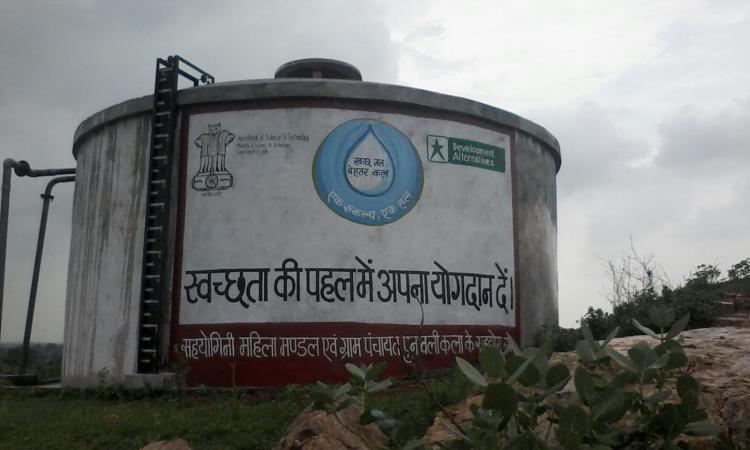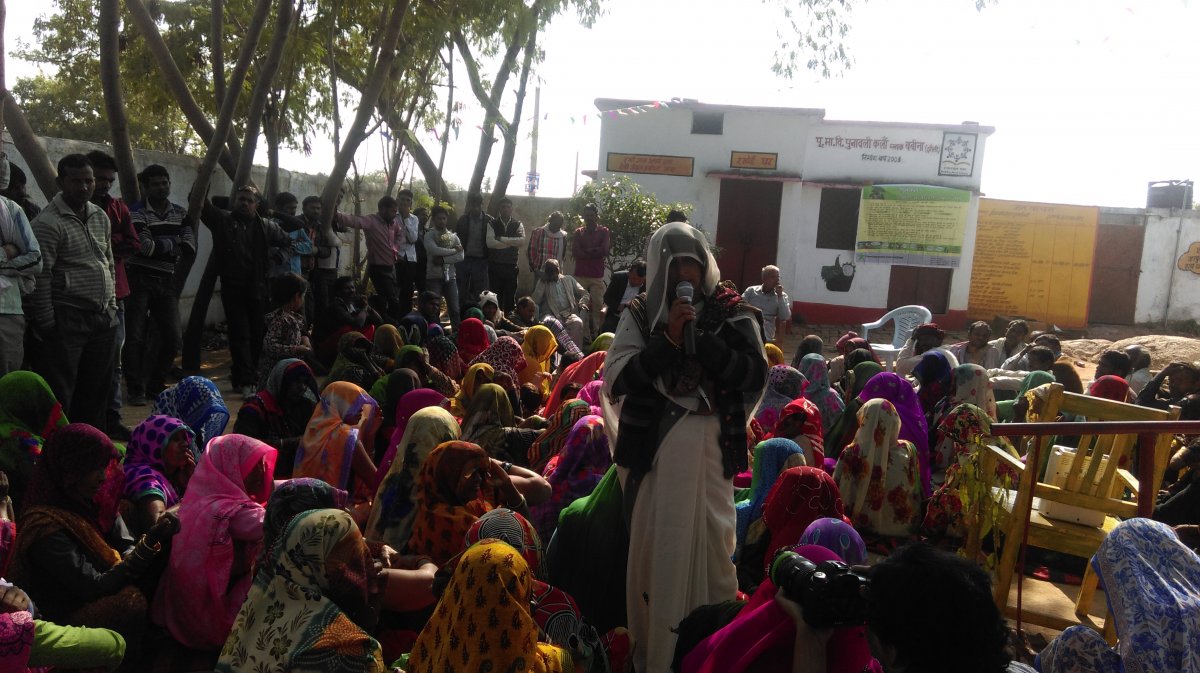
This story is of Punawli Kalan village in Uttar Pradesh, where a community with the support of a women-led federation, solved its water woes by developing a community-owned water supply system.
Punawli Kalan village is situated in Jhansi district, in the drought-prone Bundelkhand region of Central India. The village is located 17 kilometers away from the district headquarters, and has a total population of 2,918 people distributed across 608 households. About 32% of the total population belongs to Scheduled Castes, 65% to other backward class and the remaining 3% belong to general caste. The settlement pattern of the village is divided into nine hamlets, each of which is distributed across community lines.

About two decades ago, the people of Punawli Kalan started to feel the impacts of increasing climatic vulnerability, much like other parts of Bundelkhand. Drought in 2002 -2003 not only impacted the agrarian economy of the village badly but also adversely affected their lives, with inadequate access to basic needs such as water and sanitation facilities. The entire population had to depend on 20-22 hand pumps and open wells for drinking water, most of which were seasonal. Dug wells and masonry wells ran dry during summer, and depleting groundwater tables left most of the hand pumps defunct.
Piped dreams
The Uttar Pradesh Government launched a programme named ‘Swajal’ under the State Water & Sanitation Mission (SWSM) with the objective to provide water supply to rural populations. A piped water supply system was established in Punawli Kalan under the programme. Water User Groups (WUGs) were formed for the management and maintenance of the infrastructure established. The system was operational till 2010, but as operational costs continued to escalate and funds dried up, the WUGs dispersed and the system rapidly slid into disrepair.
The collapse of the piped water supply system left the community helpless - they had come to depend entirely on this as their source of water, ignoring any alternate water resources. Out of 22 hand pumps, 7 were already dried up and water from 90% of the rest was tested to have high values of iron and hardness and thus was not worth usable for domestic purpose too. Open wells had also not been maintained, with many turning into garbage dumps. As a result, by 2015 only two hand pumps and one well remained usable, and these bore the onus of quenching the thirst of all 2900 people of the village.
In summer, to ensure water availability to the family, women from the village had to travel about three kilometres, spending a minimum of two hours a day fetching water. The time wasted in collecting water could have been spent working and earning money for the adult women; it also led to more girls dropping out of school.
Lack of water meant poor sanitation that further accentuated health problems. The monsoon amplified the crisis even more, with water quality deteriorating and water borne diseases increasing.
In this situation, adequate supply of safe drinking water had become merely a dream to the village. The people wanted to revive the pipeline system. Part of their despair stemmed from the fact that numerous appeals over the years to the government requesting them to resolve the situation had yielded only empty promises. Water woes often dominated discussions in self help group (SHG) meetings.
Women power
 In the meanwhile, women SHGs from 25 villages (including Punawali Kalan) formed a women’s federation called Sahyogini Mahila Mandal. At one meeting, when the concerns of water and sanitation were being discussed by the federation members, Mamta Bundela, the president of the federation and a resident of Punawli Kalan village proposed that the federation take up the role of restoration of the defunct drinking water system and its subsequent management. With the agreement of the members, it was decided that an open meeting would be organised in the village and the federation would present its proposal.
In the meanwhile, women SHGs from 25 villages (including Punawali Kalan) formed a women’s federation called Sahyogini Mahila Mandal. At one meeting, when the concerns of water and sanitation were being discussed by the federation members, Mamta Bundela, the president of the federation and a resident of Punawli Kalan village proposed that the federation take up the role of restoration of the defunct drinking water system and its subsequent management. With the agreement of the members, it was decided that an open meeting would be organised in the village and the federation would present its proposal.
Accordingly separate meetings were held in the village with specific target groups such as panchayat members, members of former water user group, ASHA -Anganwadi functionaries, WSHG members and other community people. During a focused group discussion in the village, the proposal was shared by the federation and the community unanimously adopted a resolution that the responsibility of restoration and management of the drinking water system would be handed over to the federation.
It was also decided that the users would pay the required repairing cost as well as a household level monthly fee to the federation for further maintenance. A one time installation charge of 500 rupees per connection was contributed by the community, totalling about Rs. 56,500 from 113 connections. The users would also pay a service charge of 100 rupees per month per connection and a fine of 10% of the monthly charge would also be applicable for users who failed to pay within the month, as jointly decided by the federation and the community. With the funds thus collected, a new pump was purchase and installed. After four months of hard work, Independence Day 2015 saw the inauguration of the restored and upgraded system.
Today with the water tank of 65,000 litres storage capacity, about 2000 people of the village are accessing drinking water at their doorstep through 113 tap connections to meet the per capita drinking water requirement of 43 lpcd. This is twice as much as before, and also meets the present norms laid out in the National Water Policy for rural areas. Under the leadership of the federation, nearly Rs. 2.25 lakhs have been collected in 18 months of operation, which is for maintenance of the infrastructure. One community member has been employed by the federation to run the water motor, maintaining the pipeline system and collecting the service charges from households. Periodic water quality testing and disinfection of the main source has been undertaken by the federation to ensure safe accessibility of drinking water. An eleven-member WASH monitoring committee comprising of the Pradhan of the local panchayat, members of the federation and frontline functionaries and representatives from each ward of the village has been formed to streamline the pipeline operation as well as for decision making on issues related to WASH.
During the gram sabha on January 26, 2016, the women SHG members of the village, led by the federation have put a proposal to the panchayat to expand the pipeline service to the rest of the households and the nearby schools so that 100% households can have doorstep water accessibility. The panchayat has primarily agreed to allocate some funds in the next financial year’s plan for the expansion of the pipeline whereas the rest of the amount will be contributed by the community itself. Installation of a waste water treatment tank and water meters to reduce wastage of water and improve the efficiency of the system have also been endorsed by the gram sabha.
The one year intervention have brought in certain changes in the water and sanitation scenario in the village. A key learning from it has been that collective action with participatory planning can yield better results. The collective effort made by the community of Punawli Kalan village under the leadership of an apex body i.e. the federation, resulted in increased accessibility to safe water at a household level. In addition to the improved accessibility and quality, the endeavor has also reduced drudgery for women.
Another interesting observation was that one successful intervention translated into the desire for another - with ensured water availability in the households, the community started realising the need for better sanitation in their village, in terms of improved toilet facilities, household waste management systems and water conservation through wastewater treatment facility. 100 households have already placed applications to the panchayat for construction of toilets, which will be started within a month.
Demand driven approach and community contribution are crucial for effective and sustainable implementation: The water supply system was a real need for this village, particularly the women. Capacity building of the users, the community and the institution is necessary to ensure the sustainability of such an intervention in the long run.
This case depicts that the persistent problem of drinking water can be best tackled by building capacities of community institutions to take leadership role in local service delivery and with proper representation of the community. An area that was once water scarce, is today water secure.
The author works for Development Alternatives, the world's first social enterprise dedicated to sustainable development.
/articles/no-more-thirst